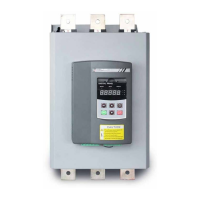
Do you have a question about the Powtran PR5200 and is the answer not in the manual?
| Input Voltage | 380V/220V |
|---|---|
| Frequency Resolution | 0.01Hz |
| Speed Control Precision | ±0.5% (SVC) |
| Torque Control Precision | ±5% |
| Starting Torque | 0.5Hz/150% (SVC) |
| Input Frequency | 50Hz/60Hz |
| Rated Power | Depends on model |
| Control Mode | V/F control |
| Overload Capacity | 150% for 60 seconds |
| Speed Adjusting Range | 1:100 (SVC) |
| Carrier Frequency | 1kHz to 15kHz |
| Communication Function | RS485, Modbus |
| Output Voltage | 0 to input voltage |
| Output Frequency | 0 to 400Hz |
| Protection Features | Overload, overvoltage, undervoltage, overheat, short circuit |
| Operating Temperature | -10°C to 40°C |
| Storage Temperature | -20°C to 60°C |
| Humidity | Below 90% RH (non-condensing) |
| Altitude | Up to 1000m without derating |
PR5200(C) soft starter incorporates advanced motor control theory and technology.
Key functions include reducing starting current, stress, and soft stop capabilities.
Highlights human-centered design, quality assurance, and protection functions.
Explains the product nameplate and model designation breakdown.
Provides a checklist for inspecting the product after unpacking.
Details operating conditions like power supply, motor type, and environment.
Specifies installation direction, distance, and cabinet ventilation.
Provides physical dimensions and mounting details for installation.
Illustrates the main power and control circuit connections.
Details the function of each external terminal for control and signals.
Describes the specific external terminals for the PR5200C model.
Shows the main circuit wiring specific to the PR5200C model.
Explains how to use the control panel buttons and displays.
Details various programmable parameters and their settings.
Describes how to configure programmable relay outputs for timing or state.
Explains how power-on terminal operation affects protection and startup.
Covers additional settings like parameter modification allowance.
Provides information on display codes, fault codes, and software version.
Details various protection mechanisms and their configurable parameters.
Explains how to set protection levels based on application needs.
Step-by-step guide for performing initial power tests.
Discusses different starting modes and their suitability for various loads.
Explains soft stop and free stop modes and their uses.
Covers specific applications like parallel motors and long cables.
Provides example parameter settings for different load types.
Overview of the Modbus RTU protocol used for communication.
Details register addresses and their functions for communication.
Lists and explains error codes and response types.
Provides important notes and precautions for RS485 communication.
Lists fault codes, their descriptions, and recommended troubleshooting steps.
Provides a table of product models, power ratings, and associated components.
Outlines the terms and conditions of the product warranty.
Lists conditions under which warranty may not apply.
